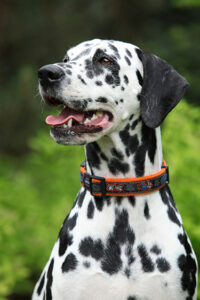CVM Researcher in Global Partnership to Combat Pet Epilepsy

Epilepsy remains the most common and perplexing of chronic neurological pet diseases despite decades of research by veterinary neurology clinicians and neuroscientists around the world. In the U.S. alone some 780,000 dogs are diagnosed with the disease each year. Karen Munana, a professor of neurology at North Carolina State University’s College of Veterinary Medicine, is a member of a four-person U.S. contingent to the recently formed International Veterinary Epilepsy Task Force (IVETF) that hopes to make inroads against the illness.
An international body of veterinarians and scientists, the IVETF was formed in 2014 to develop a set of unified and standardized guidelines for the research, diagnosis, and treatment of canine and feline epilepsy. “Lack of consistency among epilepsy researchers concerning classifications, definitions, and therapeutic outcome measures makes it difficult to draw comparisons and significantly limits the scientific impact of the studies,” says Dr. Munana. “This affects the development of effective professional guidelines which, in turn, hinders clinicians when they are diagnosing the disease and advising owners on treatment options for the pet’s condition.”

Composed of 21-member institutions, the IVETF seeks, for the first time ever in veterinary medicine, to provide veterinarians, breeders, and pet owners with critical information on various aspects of epilepsy. The organization has already produced ‘consensus statements’ that outline recommendations and classifications on various aspects of the condition.
IVETF’s collaborative approach is developing a common language to be used in the “chain of care” from the animal’s breeder and owner through the practitioner to the neurology specialist and neuroscientist. Each consensus statement aims to be a user friendly, pragmatic, reliable and valid tool that benefits all these groups to improve care for patients. The IVETF is also building a scientific and clinical framework to set standards for clinical trials and manage epilepsy research appropriately. The consensus statements involve the topics of 1) definition, classification and terminology; 2) diagnostic approach; 3) current understanding of idiopathic epilepsy of genetic or suspected genetic origin in purebred dogs; 4) medical treatment of canine epilepsy in Europe; 5) outcome of therapeutic interventions in canine and feline epilepsy; 6) veterinary epilepsy-specific MRI protocol; 7) systematic sampling of brain tissues from epileptic dogs and cats.
“I feel privileged to work with colleagues from around the world in developing these important consensus statements,” says Munana, who also is a member of the NC State Center for Comparative Studies and Translational Research. “With my clinical interest and research focus on canine epilepsy, I believe it will be invaluable to have a common language when discussing the causes, diagnosis, and treatment of the disease.”
Any breed of dog or cat can develop epilepsy. Certain dog breeds, such as the Golden Retriever, Beagle, Border Collie, Dalmatian, English springer spaniel, Irish Wolfhound, Labrador Retriever, and Standard Poodle have a genetic predisposition to the disorder.
In addition to Munana and the Veterinary Hospital at NC State University, the other U.S. representatives to the IVETF include:
- Ned Patterson, University of Minnesota College of Veterinary Medicine
- Simon Platt, University of Georgia College of Veterinary Medicine
- Michael Podell, Chicago Veterinary Neurology and Neurosurgery.
The other IVETF institutional members include:
[toggle] [toggle_content title=”Australia”]
- University of Melbourne, Victoria
[/toggle_content]
[toggle_content title=”Austria”]
- University of Melbourne, Victoria
[/toggle_content]
[toggle_content title=”Belgium”]
- Department of Small Animal Medicine and Clinical Biology, Ghent University
[/toggle_content]
[toggle_content title=”Denmark”]
- Department of Veterinary and Clinical Sciences, University of Copenhagen [/toggle_content]
[toggle_content title=”Germany”]
- Department of Small Animal Medicine and Surgery, University of Veterinary Medicine, Hannover
- Department of Pharmacology, Toxicology and Pharmacy, University of Veterinary Medicine, Hannover
- Clinic of Small Animal Medicine, Centre for Clinical Veterinary Medicine, Ludwig-Maximilians-University, Munich
- Section of Clinical & Comparative Neuropathology, Centre for Clinical Veterinary Medicine, Munich
- Department of Pharmacology, Toxicology and Pharmacy, Munich.
[/toggle_content]
[toggle_content title=”United Kingdom”]
- School of Veterinary Medicine, University of Surrey, Surrey
- Fitzpatrick Referrals, Surrey
- Department of Clinical Science and Services, Royal Veterinary College, Hertfordshire
- Fernside Veterinary Centre, Hertfordshire
- Animal Health Trust, Suffolk
- Vet Extra Neurology, Broadleys Veterinary Hospital, Stirlingshire
[/toggle_content]
[toggle_content title=”Spain”]
- Department of Animal Medicine and Surgery, Universitat Autònoma de Barcelona [/toggle_content]
[toggle_content title=”The Netherlands”]
- Department of Clinical Sciences of Companion Animals Utrecht University, Utrecht [/toggle_content]
[/toggle]
For Further Reading:


